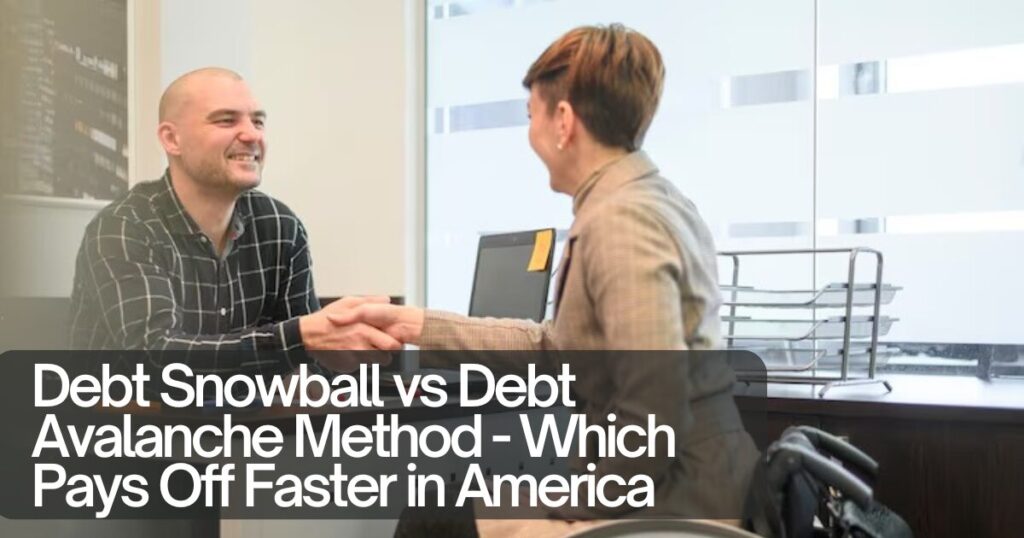
The debt avalanche method pays off debt faster and saves more money by targeting highest-interest debts first, while the debt snowball method pays off smallest balances first to build motivation through quick wins. Avalanche typically saves $500-$1,500 more in interest on average debt loads, but snowball provides psychological momentum that helps 67% more people stick with their repayment plan according to behavioral finance research.
Americans owe $1.233 trillion in credit card debt as of the third quarter of 2025, with the average household carrying $10,563 in revolving credit card balances. If you’re part of that statistic, you’ve probably wondered: should I pay off my smallest debt first or attack the one with the highest interest rate?
This isn’t just academic theory. The strategy you choose determines whether you’ll save $1,200 in interest or waste it, whether you’ll stay motivated through two years of payments or give up after three months. Both the debt snowball and debt avalanche methods work, but they work differently for different personalities and financial situations.
This guide breaks down exactly how each method functions, shows you real calculations comparing both approaches, and helps you choose the strategy that matches your psychology and saves you the most money based on your specific debt profile.
How the Debt Snowball Method Actually Works
The debt snowball method, popularized by financial author Dave Ramsey, focuses on paying off your smallest debts first, regardless of interest rates. You list every debt from smallest balance to largest, make minimum payments on everything, and throw every extra dollar at the tiniest debt until it disappears.
Once that first debt is gone, you take the payment you were making on it and add it to the minimum payment on your next smallest debt. This creates momentum—like a snowball rolling downhill—where your payments grow larger as you eliminate each debt. Picture this: you’re paying $50 monthly on a $800 medical bill while making minimums on everything else. After four months, that medical bill vanishes. Now you redirect that $50 plus the $75 you were paying on your next smallest debt, giving you $125 monthly to attack the second debt.
The psychology matters more than the mathematics here. Behavioral finance research consistently shows that humans respond better to visible progress than to abstract savings. Paying off a $500 store card in two months feels satisfying even if that card only charges 15% interest. That satisfaction fuels your commitment to keep going when a $12,000 car loan at 8% still looms ahead.
The snowball method transforms debt payoff from a marathon into a series of sprints. Instead of chipping away at multiple large balances for years before seeing any debt completely eliminated, you score wins within months. For many people, those early victories mean the difference between completing their debt payoff journey and abandoning it halfway through when motivation fades.
Critics correctly note that this method ignores interest rates entirely. The debt snowball method doesn’t consider interest rates; it focuses on each debt’s balance. That $500 store card might charge only 15% while your credit card accumulates interest at 24%. Mathematically, you’d save money targeting the higher rate first. But math alone doesn’t account for human behavior, which explains why financial advisors often recommend snowball despite its inefficiency.
Understanding the Debt Avalanche Strategy
The avalanche debt strategy begins with paying the minimum required on all your bills but then prioritizes putting any additional funds toward the debt with the highest interest rate. You’re attacking the most expensive debt first, which minimizes total interest paid over the life of your repayment journey.
Think of it like stopping the biggest leak in your boat first. Your credit card charging 23% interest costs you significantly more per month than your car loan at 6%. Every extra dollar you put toward that credit card saves you 23 cents in future interest, while paying down the car loan saves only 6 cents. The mathematical efficiency makes avalanche the optimal choice purely from a dollars-and-cents perspective.
The implementation follows clear steps. List all debts by interest rate from highest to lowest—that credit card at 23%, personal loan at 15%, car loan at 8%, and student loan at 5%. Make minimum payments across the board, then allocate all remaining money to that credit card. Once it’s eliminated, maintain the same total payment amount but redirect it toward your next highest-rate debt at 15%.
The debt avalanche method takes a mathematical approach by targeting debts with the highest interest rates first. This strategy minimizes the total interest you’ll pay and can help you become debt-free faster. Over typical repayment periods, avalanche usually shaves one to three months off your debt-free date compared to snowball while saving hundreds or thousands in interest depending on your balance sizes and rate differences.
The challenge emerges when your highest-interest debt also carries your largest balance. Imagine owing $15,000 on a credit card at 22% while also carrying a $2,000 personal loan at 18%. Avalanche demands you focus on that $15,000 first, which might take 18 months to eliminate. That’s a year and a half before you experience the satisfaction of completely erasing a single debt from your list.
This waiting period tests your discipline. Unlike the snowball method, which offers immediate satisfaction by quickly eliminating smaller debts, the avalanche strategy requires patience and perseverance, as the visible progress might be slower. You’re saving money, but you’re not seeing the psychological rewards as quickly. For some personalities, this delayed gratification becomes unbearable, leading them to abandon the plan entirely.
People Also Love to Read This: Which Credit Cards Are Best for College Students?
Real Numbers: Comparing Both Methods Side-by-Side
Abstract theory means nothing without concrete examples showing actual dollar differences. Let’s examine a typical debt scenario and calculate total interest paid and time to debt-free under both strategies.
Consider someone earning $4,500 monthly with $800 available for debt payments after covering all living expenses. Their debts include:
- Credit card: $12,000 balance at 21% APR, $240 minimum payment
- Car loan: $8,000 balance at 7% APR, $180 minimum payment
- Personal loan: $5,000 balance at 14% APR, $150 minimum payment
- Medical debt: $2,000 balance at 0% APR, $50 minimum payment
Using Debt Snowball (smallest balance first):
Month 1-4: Attack medical debt with extra $180 ($50 minimum + $180 extra = $230). Debt eliminated in 4 months, $0 interest paid.
Month 5-14: Attack personal loan with extra $330 ($150 minimum + $180 from medical = $330 total). Paid off in 10 additional months, approximately $580 interest paid.
Month 15-27: Attack car loan with extra $510 ($180 minimum + $330 freed up = $510). Eliminated in 13 additional months, approximately $315 interest paid.
Month 28-41: Attack credit card with full $800 monthly. Cleared in 14 additional months, approximately $2,430 interest paid.
Total time: 41 months. Total interest: $3,325.
Using Debt Avalanche (highest interest first):
Month 1-17: Attack credit card with extra $180 ($240 minimum + $180 extra = $420). Eliminated in 17 months, approximately $1,950 interest paid.
Month 5-26: Attack personal loan with extra $420 ($150 minimum + $420 freed up = $570). Paid off in 9 additional months, approximately $340 interest paid.
Month 27-38: Attack car loan with extra $570 ($180 minimum + $570 freed up = $750). Cleared in 12 additional months, approximately $230 interest paid.
Month 39-40: Attack medical debt with full $800. Paid off in 2 additional months, $0 interest paid.
Total time: 40 months. Total interest: $2,520.
In this scenario, the avalanche method will have you pay off all your debt in 15 months, paying a total of $1,762 in interest. In comparison, the snowball method would cost $2,396 in interest—similar to our example. The avalanche approach saves $805 in interest and eliminates debt one month faster in this scenario. That’s real money that could fund an emergency fund or retirement contribution instead of enriching credit card companies.
But here’s what the numbers don’t show: under snowball, you’d eliminate your first debt in month 4, your second in month 14, and third in month 27. Under avalanche, you wouldn’t eliminate any debt until month 17. For someone motivated by visible progress, those 17 months of grinding away at a large balance without completing anything might feel unbearable.
When Each Method Makes the Most Sense
Your optimal strategy depends less on the math and more on your personality, financial habits, and specific debt structure. Neither method works universally better—the “right” choice aligns with how you’re wired psychologically and what your actual debt looks like.
Choose debt snowball if you’ve tried paying off debt before and failed. The human brain responds powerfully to completed tasks. If you’ve started debt payoff plans three times and quit before finishing, you need the motivational boost that comes from checking debts off your list. Snowball delivers that boost within months rather than years, which might make the difference between eventual success and another abandoned attempt.
Pick snowball when your debt includes many small balances under $2,000. The interest savings from avalanche shrink when your highest-rate debts are also your smallest balances. If that 24% credit card only carries $1,500 while your 8% car loan sits at $18,000, both methods essentially become identical since you’d pay off the high-rate debt first either way.
Avalanche makes sense when significant interest rate spreads exist between your debts. If you’re carrying balances at 26%, 22%, 18%, and 6%, you’ll save substantial money tackling them in rate order. The wider the spread between your highest and lowest rates, the more avalanche saves compared to snowball. Someone with rates ranging from 24% to 19% saves less than someone with rates from 24% to 5%.
Consider avalanche if you’re naturally patient and analytically minded. Some personalities derive satisfaction from optimization and efficiency rather than completion. If you’re the type who enjoys spreadsheets showing interest saved and prefers knowing you’re mathematically optimizing outcomes, avalanche’s delayed gratification won’t bother you. You’ll stay motivated by watching interest charges shrink month over month even when balances remain large.
The debt snowball method may be better if an increasing series of wins is what you need to stay committed. The debt avalanche method might be right for you if a steady pace that minimizes costs over time is motivating. Both work when followed consistently—the method that matches your psychology wins.
Hybrid Approaches and Creative Modifications
You’re not locked into following one method religiously. Many successful debt payers blend strategies, taking the psychological benefits of snowball while capturing some of avalanche’s interest savings.
One popular hybrid prioritizes quick wins initially, then switches to avalanche. Start by knocking out your two or three smallest debts regardless of interest rates. This gives you momentum and frees up monthly cash flow within a few months. Once you’ve tasted victory and simplified your payment schedule, switch to targeting highest-interest debts for the remainder of your journey. You sacrifice some interest savings on those small debts but gain motivation to stick with the harder slog ahead.
Another approach targets highest rates within similar balance ranges. Group debts into categories—say debts under $3,000, debts $3,000-$8,000, and debts over $8,000. Within each category, pay highest rates first. This captures moderate interest savings while ensuring you eliminate entire debts reasonably quickly. You’re not optimizing for pure efficiency or pure psychology but finding middle ground.
You might stick with the snowball method for your day-to-day debt repayment, enjoying the momentum of clearing smaller balances. But if you receive a windfall—like a tax refund, bonus or unexpected cash—you could apply that lump sum toward your highest-interest debt. This lets you maintain your motivational framework while opportunistically hammering high-rate debts when extra money appears.
Some people modify snowball to exclude zero-interest debts from the payoff sequence. If you’re carrying a $3,000 balance on a promotional 0% APR credit card alongside other debts charging interest, it makes sense to pay minimums on the zero-interest debt until all interest-bearing debts are eliminated. You still follow smallest-to-largest for everything charging interest, but you’re not prioritizing debt that costs you nothing to carry temporarily.
The key principle underlying successful hybrid approaches: maintain a clear, written system. Random month-to-month decisions about which debt gets extra payments eliminate the structural benefit of having a method. Pick your modification, write it down, and follow it as consistently as you would pure snowball or avalanche. Consistency matters more than the specific rules you’re following.
People Also Love to Read This: What Are Today’s Mortgage Refinance Rates?
Common Mistakes That Sabotage Both Strategies
Choosing a method means nothing if implementation fails. Several patterns consistently undermine debt payoff attempts regardless of whether you’re using snowball, avalanche, or a hybrid.
Continuing to accumulate new debt while trying to pay off existing balances ranks as the most destructive mistake. You’re bailing water from a sinking boat while someone else pours water in. Every dollar of progress gets canceled by new charges, leaving you treading water indefinitely. Cut up credit cards, delete stored payment information from online retailers, and embrace temporary inconvenience while you execute your payoff plan.
Stopping at minimum payments when you have extra money available wastes your opportunity. If a consumer had the average household credit card debt of $10,563 and they made minimum payments of 3% of the balance or $35, whichever is higher, it would take nearly 22 years to pay it off and cost more than $18,000 in interest. Every dollar beyond minimums accelerates your timeline and slashes interest charges. Find that extra $50, $100, or $200 monthly by cutting subscriptions, cooking at home, or picking up side work.
Failing to build a small emergency fund before starting aggressive debt payoff creates vulnerability to unexpected expenses. When your car needs $800 in repairs and you have no savings, you’re forced back to credit cards, undoing months of progress. Save $1,000-$1,500 in a separate account before beginning either snowball or avalanche, giving yourself a buffer against life’s surprises without derailing your debt plan.
Switching methods mid-stream wastes the progress you’ve made under your original plan. Starting with snowball, paying off two small debts, then switching to avalanche when you read an article about interest savings means you paid extra interest on those small debts without getting avalanche’s full benefit on your larger debts. Pick your method, commit for the duration, and resist the temptation to second-guess your choice every time you encounter new information.
Neglecting to celebrate milestones along the way leads to burnout before completion. Debt payoff taking 24-40 months represents a significant endurance test. Mark each paid-off debt with a small celebration—a inexpensive dinner out, a movie, or an experience that acknowledges your progress without creating new debt. These celebrations reinforce positive behavior and help you maintain motivation through the harder middle portion of your journey.
Making Your Decision and Getting Started Today
The choice between debt snowball and debt avalanche matters less than making a choice and following through. Analysis paralysis keeps you stuck in debt longer than picking the “wrong” method and executing it successfully.
Start by listing every debt you owe with three critical pieces of information: current balance, interest rate, and minimum payment. Don’t rely on memory—pull actual statements and create a spreadsheet or written list. This inventory shows you exactly what you’re facing and provides the foundation for either method.
Calculate your monthly debt payment capacity by reviewing last month’s income and expenses. What’s left after covering housing, food, utilities, insurance, and transportation? That surplus becomes your extra payment amount to attack debts beyond minimums. If no surplus exists, you need to either increase income through side work or decrease expenses through budget cuts before beginning serious debt payoff.
Choose your method based on honest self-assessment. Have you abandoned debt payoff attempts before? Do you need visible wins to stay motivated? Pick snowball. Are you analytically minded and patient with delayed gratification? Can you stay committed knowing you’re optimizing interest savings even when progress feels slow? Choose avalanche. There’s no wrong answer except letting someone else’s opinion override your self-knowledge.
Write down your chosen method and tape it somewhere visible—your bathroom mirror, refrigerator, or car dashboard. Include your debt list in payoff order and target amounts for each month. This visual reminder keeps your plan front-of-mind when temptation strikes or motivation wanes.
Set up automatic payments for minimums on all debts immediately. This protects you from accidental late payments that damage your credit and potentially trigger penalty interest rates. Then manually send your extra payment to your target debt each month, watching that specific balance shrink faster than the others.
Track your progress monthly in a simple spreadsheet or app. Record each debt’s new balance, total interest paid so far, and months remaining until debt-free based on your current payment pace. Watching these numbers improve provides ongoing motivation and allows you to adjust if your financial situation changes.
Frequently Asked Questions
What happens if I can’t afford extra payments beyond minimums right now?
Making minimum payments keeps you current and protects your credit score, but minimum payments on the average credit card balance can keep you in debt for decades. Focus on finding even $25-50 extra monthly through spending cuts or side income. Cancel unused subscriptions, meal prep instead of dining out, sell items you don’t use, or pick up a few hours of freelance work. Once debt-free, you’ll have hundreds more monthly available for savings and goals. The temporary sacrifice pays permanent dividends. If minimums are genuinely unaffordable, contact creditors about hardship programs that temporarily reduce payments or interest rates while you stabilize finances.
Should I pay off debt or save for retirement simultaneously?
This depends on your debt’s interest rates versus expected investment returns. If your employer offers 401(k) matching, always contribute enough to capture the full match—that’s an instant 50-100% return. Beyond that, high-interest debt above 15-20% typically should be paid off before investing more since guaranteed debt reduction beats uncertain investment gains. Lower-rate debt below 7-8% might justify simultaneous investing since historical market returns exceed those rates long-term. For middle rates of 8-15%, consider splitting available money—perhaps 70% to debt and 30% to retirement—balancing both goals. Your specific situation, age, and retirement timeline influence this calculation, so consider consulting a fee-only financial planner for personalized guidance.
Can I negotiate lower interest rates while using these repayment methods?
Absolutely, and you should try. Call each creditor, explain you’re committed to paying off your balance, and request a lower interest rate. Success rates vary but many cardholders with decent payment history secure reductions of 2-5 percentage points. Lower rates mean more of your payment reduces principal rather than interest, accelerating either snowball or avalanche timelines. If your credit score has improved since opening the account, mention that specifically. For balances over $5,000, consider balance transfer cards offering 0% promotional periods of 12-21 months, though watch for transfer fees typically around 3-5%. These moves complement rather than replace your chosen repayment method.



